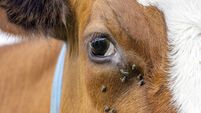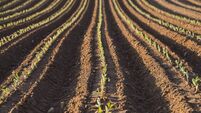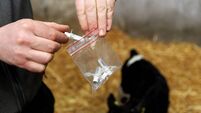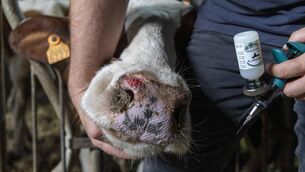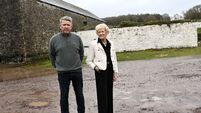Iconic Irish Dexter breed introduced to the Áras
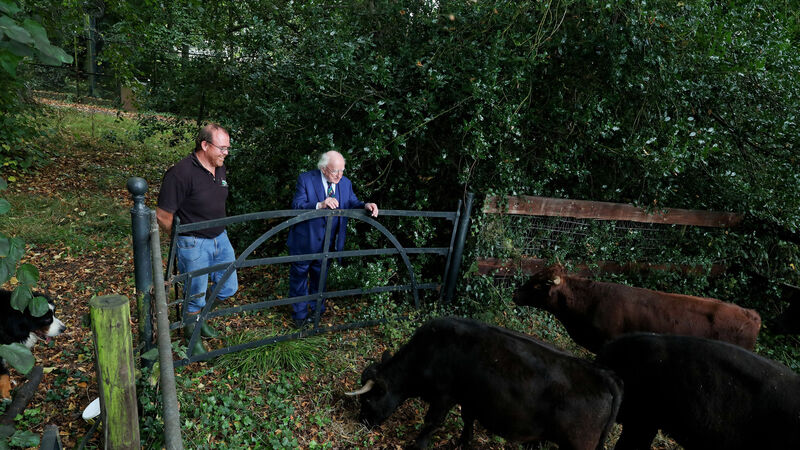
President Higgins welcomed Peter Bryans of Donabate Dexter Farm to Áras an Uachtaráin, as he delivered seven indigenous dexter cattle for the beginning of their three-month stay in the grounds of Áras an Uachtaráin. Picture: Maxwells
A renewed focus is being put on two iconic native Irish cattle breeds with a shared history stemming from the days of the Celts.
Seven indigenous Dexter cattle have started a three-month stay in the grounds of Áras an Uachtaráin as part of a programme of work to enhance the biodiversity of the 130-acre site.
The arrangement arises from a decision by President Michael D Higgins to commission an audit by the Office of Public Works.
Scientists from Trinity College, Dublin, who conducted the year-long study, recommended a sustainable growing regime for the Áras grounds.
It combines appropriate mowing to reduce the nutrient load in the soil, the introduction of grass-suppressing yellow rattle, a grassland plant, and the presence of livestock to improve the biodiversity of the meadows.
The purpose of these measures is to help the growth of indigenous wildflowers, with corresponding increases in fauna dependent on a diversity of flora.
Dexter Cattle, first documented in the 1830s by David Low, Professor of Agriculture at Edinburgh University, is believed to be descended from the once-dominant Kerry breed, one of the oldest in Europe.
Traditionally in Ireland, farms were self-sustaining small holdings. With the introduction of new breeds, some indigenous species were lost.
But others including the Kerry and Dexter were saved from extinction and are still being farmed today by breeders dedicated to the preservation and promotion of these ancient cattle.
The Kerry and Dexter are hardly animals breeds that have seen Irish farmers through hard times. They can live on marginalised land, calve without trouble, winter outdoors happily and have a reputation for producing excellent beef and milk.
Indeed, the Dexter cattle in the grounds of Áras an Uachtaráin are now grazing a short distance across the Phoenix Park from their “cousins” - a herd of Kerry cows at the State-owned Farmleigh House and Estate, once the property of the Guinness brewing family.
Farmleigh, which has a working farm, began to build its herd of Kerry cattle in 2003 with Muckross House, Killarney, supplying twelve head to start it off.
Now, the Kerries at Farmleigh have competition in public appeal from the Dexters at the Áras. Both breeds have similar characteristics.
They were once known as the ‘poor man’s cow’ because they needed less land to thrive. And sometimes they grazed ‘the long acre’ and kept the fences trimmed.
Small in stature, both breeds have an ability to adapt to varying and extreme climatic conditions and to different systems of management.
The Farmleigh website describes the Kerry breed as part of the country’s cultural heritage, and the product of human and natural selection over the centuries under difficult and demanding environmental conditions.
“The Kerry are a sight to behold with their shiny black coats and their magnificent horns. Visitors can see the herd from the paths around the grounds,” it says.
On the other hand, the Dexter owes its modern appearance, name, and probably qualities to Christopher Dexter, agent to Lord Hawarden, who came to Ireland in 1750 and made his home in Dundrum, Co Tipperary.
Agent Dexter genetically selected cattle from Ireland, England, Scotland and Wales with the aim of producing a small breed of hardy, dual-purpose animals.
F. A. Hordern, a well-known judge of Kerry and Dexter cattle, noted in 1910 that there had been a great increase in the demand for the breeds, not just in Ireland but especially in the British Colonies and America.
“In my opinion the Kerry and Dexter have proved themselves to be beyond doubt among the most profitable animals of the dairy, the butcher and the show yard.
“It is also worthy of note that during a recent three weeks' test in England a Dexter cow milked the weight of herself,” he said.
Hordern noted that a herd owner in the US, Howard Gould, had purchased a Dexter bull named ‘Tom Thumb’, and a cow called ‘Little Eve’. Both were bred by George Courtenay in Kenmare, County Kerry, and won many show championships and classes.
The glory days of the Kerries and the Dexters were not to last, however, and by 1951 the then Agriculture Minister James Dillon told the Dail he was irritated to learn that ‘certain sophisticated farmers’ were bringing in other cattle breeds.
He said there was no respect for the Kerry cow because it was the Kerry cow, but if it was cow from Andalusia, a region of hills, rivers and farmland bordering Spain’s southern coast, people would be paying 200 guineas for it, and would bring it in on a passenger liner.
“If we could make Kerry cattle as remunerative as a business as the people of the Channel Islands have made of Jerseys and Guernseys, we would have secured for ‘The Kingdom of Kerry’ a not insignificant source of money,” he said Dillon claimed Kerry cattle were the only breed in the world which could live on the mountain and give milk on a scale which justified it being kept as a milch cow.
The Dexter cattle now grazing on the Áras grounds will spend a few months in their temporary new home each year. Not having them present in late spring and summer allows the native flowers an opportunity to flourish and produce seeds.
Normally based in North County Dublin, they are part of a sustainable grazing programme in Fingal County Council’s protected coastal lands.
Hailed as the smallest of the European cattle breeds, Dexters are about half the size of a traditional Hereford and about one-third the size of a Holstein Friesian milking cow.

